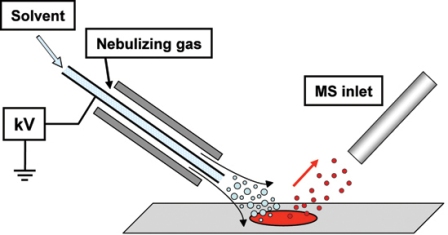Time for desorption electrospray ionization (DESI)!
This ambient ionization was created in 2004 by Zoltan Takáts, who was in Graham Cooks& #39; (Purdue Uni. and also in my research family tree) group at the time, and is believed to have started "ambient ionization".
This ambient ionization was created in 2004 by Zoltan Takáts, who was in Graham Cooks& #39; (Purdue Uni. and also in my research family tree) group at the time, and is believed to have started "ambient ionization".
DESI is a combination of electrospray (like we talked about yesterday) and surface desorption techniques because both are used in the ionization process.
Here& #39;s the setup. The sample, with your analyte, is deposited onto a surface and an electrosprayed mist (with some help from a little gas) is directed towards it. As the solvent mist travels to the sample, a thin film is formed.
Now when you& #39;re explaining DESI to your MS friends, the film is the important part so don& #39;t leave it out. Here& #39;s why.
As you create a thin film on top of your sample, your analyte gets dissolved/extracted into it, heading to the surface.
As you create a thin film on top of your sample, your analyte gets dissolved/extracted into it, heading to the surface.
And as you& #39;re spraying more mist towards the sample, analyte droplets splash in the air and start traveling towards the MS for detection.
Now if you say "secondary droplets form and travel to the MS" they& #39;ll really be impressed because that& #39;s the technical phrase for it.
Now if you say "secondary droplets form and travel to the MS" they& #39;ll really be impressed because that& #39;s the technical phrase for it.
What makes DESI and other desorption-type ionization sources cool is that you can analyze pretty much anything with a surface. A common application for DESI now is for tissue sample analysis, for this reason.
You can take a tissue slice, mount it, and sample the entire surface using DESI! They even use it for imaging studies. Think of that like taking a small "snapshot" (MS spectrum) of each part of the tissue and using that data to see where your analytes are in the sample.

 Read on Twitter
Read on Twitter


